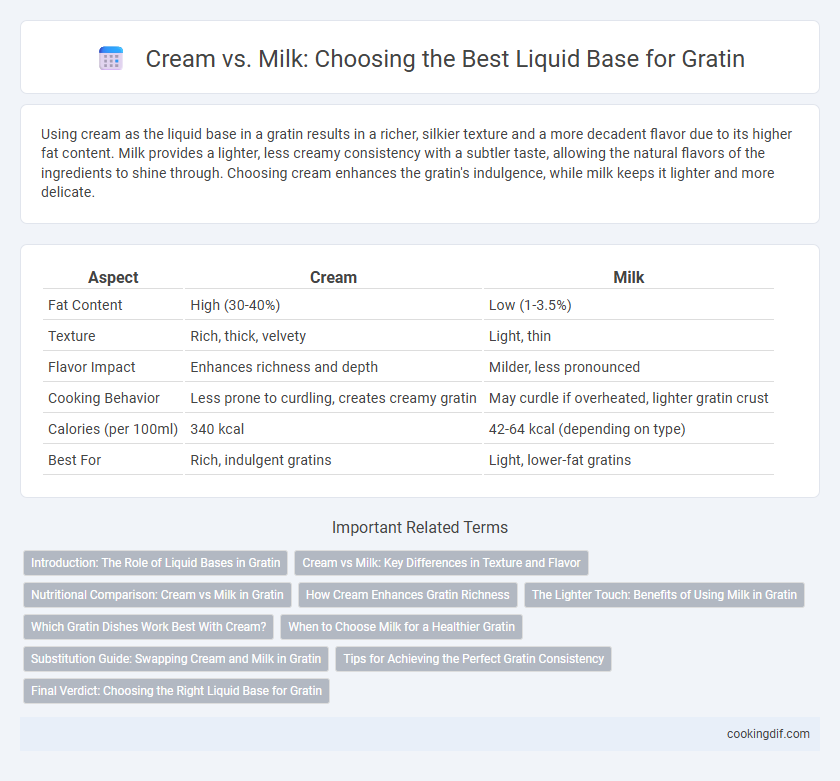Using cream as the liquid base in a gratin results in a richer, silkier texture and a more decadent flavor due to its higher fat content. Milk provides a lighter, less creamy consistency with a subtler taste, allowing the natural flavors of the ingredients to shine through. Choosing cream enhances the gratin's indulgence, while milk keeps it lighter and more delicate.
Table of Comparison
| Aspect | Cream | Milk |
|---|---|---|
| Fat Content | High (30-40%) | Low (1-3.5%) |
| Texture | Rich, thick, velvety | Light, thin |
| Flavor Impact | Enhances richness and depth | Milder, less pronounced |
| Cooking Behavior | Less prone to curdling, creates creamy gratin | May curdle if overheated, lighter gratin crust |
| Calories (per 100ml) | 340 kcal | 42-64 kcal (depending on type) |
| Best For | Rich, indulgent gratins | Light, lower-fat gratins |
Introduction: The Role of Liquid Bases in Gratin
Choosing between cream and milk as the liquid base in gratin significantly influences texture and flavor. Cream provides a rich, velvety consistency and enhances the dish's indulgent taste due to its higher fat content, while milk results in a lighter, more delicate gratin with a thinner sauce. The selection depends on the desired balance between richness and lightness, impacting the final culinary experience.
Cream vs Milk: Key Differences in Texture and Flavor
Using cream as the liquid base in gratin results in a richer, silkier texture with a more pronounced, buttery flavor, enhancing the dish's overall indulgence. Milk provides a lighter, more delicate consistency and subtle taste, allowing other ingredients like cheese and herbs to shine through more distinctly. Cream's higher fat content gives a thicker, more luxurious sauce, whereas milk creates a thinner, less creamy gratin topping.
Nutritional Comparison: Cream vs Milk in Gratin
Using cream as the liquid base in gratin significantly increases the dish's calorie and fat content, with cream typically containing around 30-40% fat compared to milk's 1-3%. Milk provides a lighter option with higher calcium content and lower saturated fat, making it suitable for health-conscious diets. The choice between cream and milk affects not only the gratin's nutritional profile but also its texture and richness, with cream delivering a thicker, more indulgent sauce.
How Cream Enhances Gratin Richness
Cream significantly enriches gratin by adding a velvety texture and a luxurious mouthfeel due to its high fat content, typically around 30-40%. This richness promotes a golden, bubbly crust with a deeper flavor profile compared to milk, which contains less fat and results in a lighter, less creamy base. The fat in cream also aids in better heat distribution and caramelization, intensifying the gratin's savory and indulgent qualities.
The Lighter Touch: Benefits of Using Milk in Gratin
Using milk as the liquid base in gratin recipes results in a lighter, more delicate texture compared to cream, making the dish less rich and easier to digest. Milk's lower fat content enhances the natural flavors of ingredients like potatoes and cheese without overwhelming them, while still providing sufficient moisture for a tender, golden crust. Choosing milk supports a balanced calorie count and creates a subtle creaminess ideal for those seeking a satisfying yet lighter gratin experience.
Which Gratin Dishes Work Best With Cream?
Gratin dishes like potato dauphinoise and seafood gratin benefit most from using cream as the liquid base due to its rich texture and ability to create a velvety sauce that complements the ingredients. Cream enhances the browning and bubbling top layer by providing higher fat content, which milk cannot achieve as effectively. Recipes featuring delicate ingredients such as scallops, lobster, or thinly sliced potatoes achieve optimal flavor and consistency with cream-based gratin.
When to Choose Milk for a Healthier Gratin
Choosing milk over cream for a gratin base reduces overall fat content while maintaining a smooth texture, ideal for health-conscious recipes. Milk's lower calorie and saturated fat profile makes it suitable for individuals managing cholesterol or seeking lighter dishes. Opt for whole or 2% milk to preserve creaminess without the richness of heavy cream, ensuring a balanced and nutritious gratin.
Substitution Guide: Swapping Cream and Milk in Gratin
Using cream instead of milk in gratin creates a richer, silkier texture due to its higher fat content, enhancing the dish's indulgence and browning potential. When substituting milk for cream, opt for whole milk to maintain some creaminess, and consider adding a small amount of butter to mimic cream's fat level for improved consistency. Adjust baking time slightly as gratins made with milk may require less time to achieve a golden crust compared to those made with cream.
Tips for Achieving the Perfect Gratin Consistency
Using cream as the liquid base in gratin recipes results in a richer, silkier texture and a luscious mouthfeel, while milk offers a lighter, less dense consistency. For perfect gratin consistency, balance the fat content by choosing heavy cream for a thicker, indulgent sauce or whole milk combined with a roux to achieve smoothness without excessive richness. Gradually incorporate the liquid, monitoring thickness as it bakes to avoid a runny or overly dry gratin, ensuring a creamy interior with a golden, crisp topping.
Final Verdict: Choosing the Right Liquid Base for Gratin
Cream provides a richer, silkier texture and intensifies the flavor of gratin, making it ideal for decadent dishes where indulgence is desired. Milk offers a lighter, less fatty alternative that still delivers creaminess while allowing other ingredients to shine, perfect for healthier or more subtle gratins. Selecting between cream and milk depends on the desired richness and caloric content, with cream favored for luxury and milk preferred for balanced, lighter textures.
Cream vs Milk for liquid base Infographic

 cookingdif.com
cookingdif.com